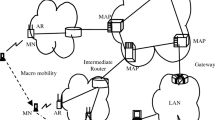Abstract
Internet of Things (IoT) services over 5G mobile networks will have unique communication characteristics of massive connectivity and sporadic small-scale data transfer. These characteristics increase the signaling overhead of C-plane message exchange associated with connection management in RAN and mobile core. 3GPP has standardized Small Data Transmission with RRC-INACTIVE that reduces this overhead. However, a new type of IoT service accompanied by device mobility is emerging. The 3GPP standard approach does not adequately account for the frequent device mobility and does not sufficiently reduce the overhead for these new IoT services. This paper proposes a new communication method for the mobility of IoT devices, which suppresses the signaling overhead of RAN and mobile core. It releases the device status management of RAN by introducing simplified status information. Our simulation results showed that the proposed method suppresses the signaling overhead compared with the 3GPP approaches. Specifically, the proposed method could reduce the signaling message exchange up to 28%.
Access this chapter
Tax calculation will be finalised at checkout
Purchases are for personal use only
Similar content being viewed by others
References
Dahlman, E., Parkvall, S., Skold, J.: 5G NR: The Next Generation Wireless Access Technology, 2nd edn. Elsevier Academic Press, London (2021)
Vittal, S., Franklin, A.A.: HARNESS: high availability supportive self reliant network slicing in 5G networks. IEEE Trans. Netw. Service Manag. 19(3), 1951–1964 (2022)
Kahn, C., Viswanathan, H.: Connectionless access for mobile cellular networks. IEEE Commun. Mag. 53(9), 26–31 (2015)
3GPP Technical Specification Group Services and System Aspects, “System architecture for the 5G System (5GS) (Release 18),” 3GPP TS 23.501, V 18.3.0, September 2023
3GPP Technical Specification Group Radio Access Network, “NR and NG-RAN Overall Description (Release 17),” 3GPP TS 38.300, V 17.6.0, September 2023
Bhatia, R., et al.: Massive machine type communications over 5G using lean protocols and edge proxies. In: 2018 IEEE 5G World Forum (5GWF), pp. 462–467, July 2018
3GPP Technical Specification Group Services and System Aspects, “Procedures for the 5G System (5GS) (Release 18),” 3GPP TS 23.502, V 18.3.0, September 2023
Oliveira, L.A.N., Alencar, M.S., Lopes, W.T.A., Madeiro, F.: On the performance of location management in 5G network using RRC inactive state. IEEE Access 10, 65520–65532 (2022)
ns-3 network simulator. https://www.nsnam.org/
Camp, T., Boleng, J., Davies, V.: A survey of mobility models for ad hoc network research. Wireless Commun. Mobile Comput. 2(5), 483–502 (2002)
Author information
Authors and Affiliations
Corresponding author
Editor information
Editors and Affiliations
Rights and permissions
Copyright information
© 2024 The Author(s), under exclusive license to Springer Nature Switzerland AG
About this paper
Cite this paper
Kato, T., Sasaki, C., Tagami, A. (2024). Reducing Signaling Overhead in 5G Mobile Network for IoT Device Mobility. In: Barolli, L. (eds) Advanced Information Networking and Applications. AINA 2024. Lecture Notes on Data Engineering and Communications Technologies, vol 199. Springer, Cham. https://doi.org/10.1007/978-3-031-57840-3_8
Download citation
DOI: https://doi.org/10.1007/978-3-031-57840-3_8
Published:
Publisher Name: Springer, Cham
Print ISBN: 978-3-031-57839-7
Online ISBN: 978-3-031-57840-3
eBook Packages: Intelligent Technologies and RoboticsIntelligent Technologies and Robotics (R0)




